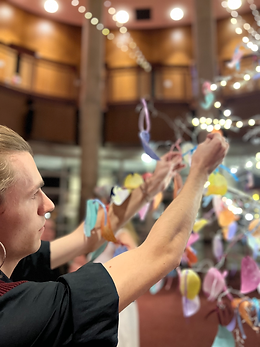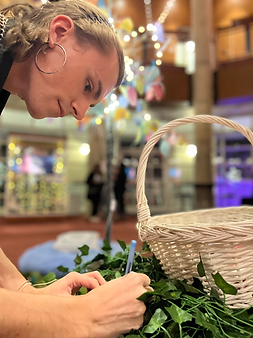top of page
AS YOU LIKE IT
by William Shakespeare
As You Like It
I was the lead dramaturg for As You Like It which ran in fall of 2022. I worked closely with the director, Peter Anderson, as this was his MFA thesis production. Peter envisioned a queer retelling of this Shakespearean text and through the casting process, we had two non-binary actors in the leading romantic roles of Rosalind and Orlando amongst an ensemble of actors portraying roles contrary to traditional casting. I worked with the design team to formulate a cohesive aesthetic vision, developed our perception of gender within our imagined world, synthesized contextual materials to assist in understanding a First Folio version of the text, cultivated close relationships with the cast to facilitate critical discussions, and created a robust audience engagement experience.



Photo by Lewis Stein
Photo by Louis Stein
Photo by Louis Stein
As You Like It Dramatugy Website
DRAMATURGY WEBSITE
During the design process and leading up to the first rehearsal, I developed a dramaturgical website to help actors, designers, and creative team members to better understand the text. Prior to this, I worked closely with the director to cut the script to our desired length, taking care to ensure cuts did not obstruct the meter or the message.
Click the image below to visit and explore the website!
The primary element of the website is an annotated script which I created by inserting hyperlinks into an online version of the script that links particular words and phrases back to the website where you can read annotations that help to clarify or expand upon the meaning or context of the text in question.
Click the image to view the script!
The director felt strongly about utilizing the First Folio version of the text to employ First Folio reading to find clues in the text regarding inflection and pronunciation. To assist with reading the Old English spellings of words and to explain how the First Folio can provide helpful hints to actors, I created a glossary page featuring a guide to reading the First Folio and pronunciation guides with recordings of my voice correctly pronouncing words spelled in Old English.
Other features of the website include:
an essay on the relationship between Shakespeare and Queerness; a page about the foundations of Shakespeare such as iambic pentameter, verse vs. prose, and an essay on pastoral conventions in the text; a timeline of our version of the play; the influence of queer music festivals on our vision; and information on the band Bandits on the Run who composed original music for our production.
As You Like It Audience Engagement
AUDIENCE ENGAGEMENT
The themes we sought to highlight in our production was the transformational power of embracing all aspects of your identity, the beauty in all the forms that love can take, and the freedom of spirit that can be found in nature. We collaborated with the New York based band, Bandits on the Run, featuring a CMU alum, to compose original music to lyrics from the text and some additional lyrics pulled from Twelfth Night. The combination of these goals led to an aesthetic vision of a dark and foreboding Court setting with live musicians gently masked in the background, which then was lifted away to reveal an expansive and colorful natural world, with a full stage of musicians inspired by the feeling of a queer outdoor musical fesitval.

Photo by David Rubin

Photo by David Rubin

With these intentions in mind, I created an audience engagement experience that was centered on building community. For the lobby display, I constructed a Tree of Love out of recycled metal materials acquired from the local Pittsburgh organization, Construction Junction.

Audiences were invited to write on a colorful leaf about a moment they experienced a profound sense of love or a transformational sense of self. They then hung the leaf on the metal tree so it blossomed into color over the course of the run.


I surrounded the tree with pillows and leftover pieces of turf from the scenic design to create a community lounge space for students and audiences to enjoy. I decorated the space with fairy lights and I was so moved to see how the CMU community joyfully took part in the experience.





The assistant dramaturg, Eliot Herron, took the lead on a display case featuring the work of Bandits on the Run and detailing their involvement in the show. With a video monitor playing their music videos.

Eliot Herron and myself with the display and members of Bandits on the Run,
Regina Strayhorn and Adrian Enscoe.

The last element of my audience engagement was a Post-Show Shin-Dig, which was a reimagining of a traditional talkback where the audience was invited to remain in the lobby following the show; actors, designers, and creative team members wore name tags to invite informal conversation. I opened the space with a speech and established community agreements verbally and with posters to maintain safeguards and boundaries. What resulted was a night of community and connection, as audience members and artists had the opportunity to share with one another the impact of seeing the exploration of gender and sexuality on the Chosky stage and through a Shakespearean text.




As You Like It Program Note
PROGRAM NOTE
The program note was key for this production to introduce the audience to the queer lens with which we approached this text. The note was largely based on the essay that I wrote for the dramaturgy website which expanded upon these same ideas to the actors and designers. My goal was to address the historic relationship that queerness has with Shakespeare and how queerness might have fit into the original context of the play, and then elaborate on how we envision bringing contemporary queer theory to the text in our rendition. I also included a map of "Who's Who in the Play" to assist the audience with keeping track of characters and their relationships to each other.
Click the button below to read the program note!
Photos by Louis Stein and David Rubin
bottom of page








































